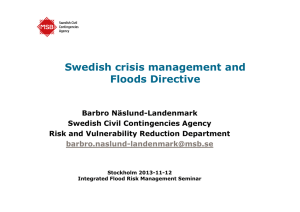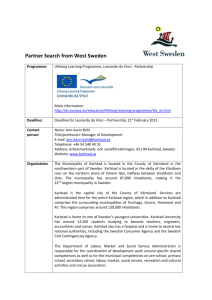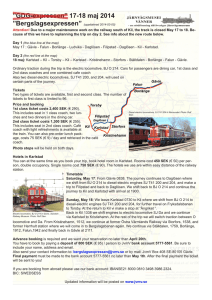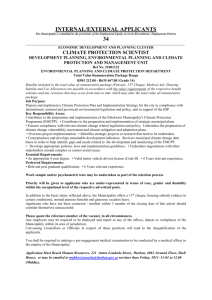Karlstad Municipality and MSB in Sweden
advertisement
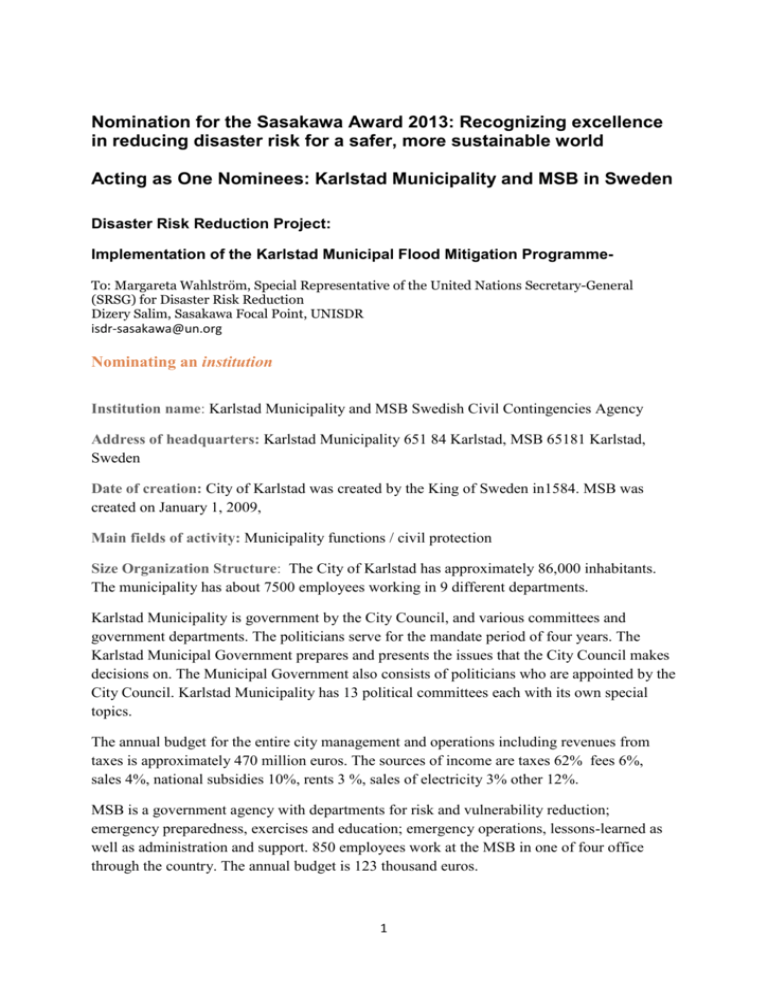
Nomination for the Sasakawa Award 2013: Recognizing excellence in reducing disaster risk for a safer, more sustainable world Acting as One Nominees: Karlstad Municipality and MSB in Sweden Disaster Risk Reduction Project: Implementation of the Karlstad Municipal Flood Mitigation ProgrammeTo: Margareta Wahlström, Special Representative of the United Nations Secretary-General (SRSG) for Disaster Risk Reduction Dizery Salim, Sasakawa Focal Point, UNISDR isdr-sasakawa@un.org Nominating an institution Institution name: Karlstad Municipality and MSB Swedish Civil Contingencies Agency Address of headquarters: Karlstad Municipality 651 84 Karlstad, MSB 65181 Karlstad, Sweden Date of creation: City of Karlstad was created by the King of Sweden in1584. MSB was created on January 1, 2009, Main fields of activity: Municipality functions / civil protection Size Organization Structure: The City of Karlstad has approximately 86,000 inhabitants. The municipality has about 7500 employees working in 9 different departments. Karlstad Municipality is government by the City Council, and various committees and government departments. The politicians serve for the mandate period of four years. The Karlstad Municipal Government prepares and presents the issues that the City Council makes decisions on. The Municipal Government also consists of politicians who are appointed by the City Council. Karlstad Municipality has 13 political committees each with its own special topics. The annual budget for the entire city management and operations including revenues from taxes is approximately 470 million euros. The sources of income are taxes 62% fees 6%, sales 4%, national subsidies 10%, rents 3 %, sales of electricity 3% other 12%. MSB is a government agency with departments for risk and vulnerability reduction; emergency preparedness, exercises and education; emergency operations, lessons-learned as well as administration and support. 850 employees work at the MSB in one of four office through the country. The annual budget is 123 thousand euros. 1 Name and title of chief executive officer: Anna Sandborgh, Chief Executive of Karlstad Municipality and Helena Lindberg, Director General of MSB For those submitting nominations Nominator’s name: Johan Palsgård, Permanent Mission of Sweden to the United Nations Address: Case Postale 190 CH-1211 Geneva 20 Switzerland Email: johan.palsgard@gov.se Present position: First Secretary for Humanitarian Affairs In less than 100 words, please describe the remarkable and innovative effort carried out by the nominee to reduce the impact of disasters and build disaster resilience. Karlstad municipality has since the 1990s worked to prevent flooding. Early on they built up a hydraulic model and sounded the river in order to model different flood scenarios. The physical properties of the river have been measured since 1940. In recent years, Karlstad Municipality has worked on building resilient and adapting to climate change City experts have communicated with citizens and other stakeholders as part of DRR. Guidelines have been written on sustainable urban planning as part of the Flood Mitigation Programme. Karlstad is at the forefront of this work among Swedish municipalities. The municipality’s politicians and government employees have built up considerable expertise on risk management. Much of the success lies in an exchange between other cities outside Sweden and other countries. To be at the forefront also means working with innovation and development of new solutions which can be seen in the flood mitigation programme. MSB has written regulations on risk and vulnerability assessments as well as guidelines for municipal risk management. Guidance, training and numerous seminars and workshops have been conducted in order to support municipalities and provincial governments in identifying specific risks such as flooding and to investigate the impacts of climate change. The DRR reports, tools, methods developed by MSB and the universities for the local level often have the purpose of strengthening decision making capabilities for flood management. MSB is also active in promoting disaster prevention at the European Union level. Much progress was made during and after the Swedish Presidency. MSB has promoted information sharing and exchanges including city –to-city learning for European Forum for Disaster Risk Reduction and the Making Cities Resilient campaign. Every year MSB monitors the development of the spring flood by collecting details from the County Administrative Boards about water discharges. In this way early signals are received about the need for barriers and other resources in the event of high water discharges and flooding. The development of other types of high water discharges is also monitored. MSB has developed and supports a digital radio communications system used by public policy, public security any public health entities in case of an emergency. The MSB is also the focal point for coordinating Swedish national information security which includes the preparedness of media contributions to societal safety. In less than 100 words, please describe how the nominee’s actions have heightened awareness about the need to reduce disaster risk. 2 Karlstad also acts as one on the international front. In 2010 Karlstad Municipality became the first city in Sweden to join the UNISDR Making Cities Resilient campaign. They entered as a champion city and a politician and city director participated in international conferences in Germany, Mexico and China) as an advocate for disaster risk reduction. Karlstad’s City Councilman Åke Pettersson Frykberg, as a champion for the campaign supported the Bonn Declaration of Mayors at the Climate Adaptation Forum. The deputy director of the city spoke about the flood mitigation program at the Shanghai Expo 2010 “Better Cities, Better Life” Shanghai in July 2010. MSB has accomplished a number of actions to bring all levels together to act as one for disaster risk reduction. MSB arranges national platform meetings, Nordic HFA meetings, seminars for municipalities to learn more about the law, and writes guidelines for implementing the laws. MSB also arranged seminars to profile the good work of the counties and municipalities specific areas of disaster risk reduction. MSB also receives government commissions for investigation related to flood risk and mitigation. Cooperation with other municipalities is important in MSB’s work. The National Platform carried out a national seminar series on the challenges of flood risk during which time cities met and presented their solutions. A handbook was published with all these examples. Thereis an example of the continual feedback and exchange of experiences. Karlstad Municipality, the County Administrative Board of Värmland and MSB all supported the establishment of the Centre for Climate and Safety at Karlstad University. These bodies contribute with financial resources and are active members of the steering group. This university collaborates with the municipality for the flood mitigation walk where researchers, government decision makers, citizens etc. can view the risks in the field and hear about the different mitigation options. Karlstad Municipality has increased the awareness of individual property owners that they need to consider the risks when purchasing or building a home. It is the homeowner’s own insurance that pays for damages that might occur. The municipality has developed brochures to citizens, information in various magazines, etc. to inform individuals of the risk and how they can reduce vulnerability. The website features updated information on how the municipality is working on these issues and that there are flood maps: http://karlstad.se/oversvamning. The municipality has also had open consultations regarding technical prevention methods. In less than 100 words, please describe how the nominee’s actions resulted in new partnerships that strengthen disaster resilience. Karlstad’s Contingency Plan for floods is in progress. Here Karlstad Municipality, together with many different actors, both private and public, are doing an inventory of how vulnerable different objects important to society are prone to flooding and what to do to protect them. Energy companies, telecom companies, health care organizations etc. are collaborating in this project. MSB works closely with universities including a special call for research proposals for climate change adaptation and disaster risk reduction. Seminars are arranged to disseminate the results. The university and the city work together not only on research projects but also with disseminating information about risks to target groups. One recommendation in the Flood Mitigation Programme was to carry out a flood exercise with the participation of all relevant actors working with rescue, environment, health, planning, engineering, property, social services, and IT. The goal of the exercise goal was to test the capability and to practice handling high flows and its consequences. This was done in collaboration with relevant 3 organizations. Through the exercise the respective players learned one another’s responsibilities and capabilities (skills and resources).They identified gaps and ambiguities. The exercise strengthened cooperation and coordination between stakeholders. It also gave clear picture of what support different actors need from each other and the rest of society. In less than 100 words, please describe how the nominee’s efforts satisfy different elements essential to reducing and mitigating disaster risk. These can include: using a multi-hazard approach, gender perspective, community participation, cultural diversity, capacity building, technology transfer and training and education. Communication is one important tool within disaster risk reduction. Karlstad has done much to educate about flood risk of Karlstad such as flood hazard maps that are published on the website. Citizens can follow the water levels on the website and a flood risk walk around the city has been established. The County helps with the flood risk walks. There is also collaboration between schools and the university regarding flood risk and mitigation. Karlstad Municipality is also part of different networks and groups, together with other municipalities and the County Administrative Board, who share the same catchment area. The MSB supports the establishment of local river coordination groups working as forums for collaboration and coordination of concerned stakeholders in the catchment area of a river. These forums increase knowledge about which coordinated actions will be taken and who is responsible for each. A river group for Klarälven River is active in discussing and finding solutions to flood risk issues. Karlstad Municipality cooperates with the County for preparedness and operations in case of an emergency. There is also collaboration for flood risk management with the Norwegian Water Resources and Energy Directorate as well as the hydropower plant owner Fortum. In less than 100 words, please describe how the nominee’s work is funded. Most financial investments are made by the Karlstad’s Technical and Property Management Department-The investigations have been funded by the Emergency Services Department and City Planning Office. European Union projects on flood risk such as EU FLOWS and SAWA (360,000 euro) have provided external funding. Karlstad Municipality has requested funds for prevention measures from national government subsidies that MSB administers. Government financing is available from the MSB budget for implementing of the EU Flood Directive on the county level and for mapping natural hazrds. New investigations are made in areas where there is a high risk of flooding to identify the risks and responsibilities for action. 4

